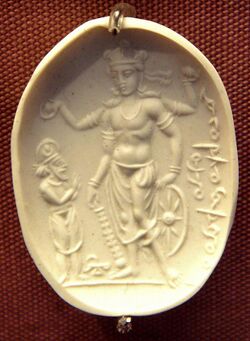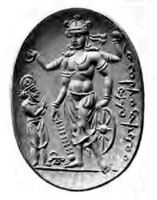Religion:Vishnu Nicolo Seal
| Vishnu Nicolo Seal | |
|---|---|
 Cast of the seal in the British Museum. | |
| Material | Agate |
| Created | 4th century CE |
| Discovered | Khyber Pakhtunkhwa, Pakistan [ ⚑ ] : 34°00′N 71°19′E / 34°N 71.32°E |
| Present location | British Museum, London |
| Registration | 1892,1103.98 |
| Lua error in Module:Location_map at line 522: Unable to find the specified location map definition: "Module:Location map/data/Gandhara" does not exist. | |
The Vishnu Nicolo Seal is a "finely engraved" oval agate seal (1.4 inches by 1.05 inch) from the Gandhara region, dated to the 4th century CE. Since 1892 it has been in the British Museum.[1]
The seal depicts a four-armed deity, probably Vishnu or Vāsudeva,[2] being prayed by a royal devotee. The deity holds Vishnu's classical attributes: the gada club, the chakra discus, the wheel and the lotus.[3][4][1] There is a two-line inscription and a monogram by the worshipper's feet.[1]
The British Museum describes the inscription as "Bactrian", transliterating it: "(1) saso reo iastoo (2) algo", translated as: "Sas-re(w) the leader of worship (?)".[1]
It was found in what was then the North-West Frontier Province of British India, now Khyber Pakhtunkhwa of Pakistan .[1]
Interpretations
The seal was first reported by Alexander Cunningham in The Numismatic Chonicle of 1893.[3][5] Cunningham, saw in the devotee the Kushan emperor Huvishka, who reigned about 140-180 BC, based on the similarity of the headdress.[4]
More recently Roman Ghirshman proposed that the text on the seal was in the Kushan script and mentions three major Hindu gods:
A more recent interpretation suggests the divinity is Vāsudeva, an early deity whose attributes were later reused in the iconography of Vishnu with the addition of an aureole.[2][7]
This recent research also identified the devotee, not with Huvishka, but with a Huna king.[5][4] The devotee could also be a Kushano-Sasanian or a Kidarite prince.[8]
The seal also suggest that a composite cult of the three deities Surya (another name for Mihira, meaning "Sun"), Vishnu and Shiva was current in India circa 500 CE.[5] However, the British Museum in 2019 gives a different reading of the inscription.[1]
| Line | Original (Greco-Bactrian script) | Transliteration | English translation |
|---|---|---|---|
| 1 | σασο ρηο ιαþτoo | Script error: The function "transl" does not exist. | "Sas-re(w) the leader of worship (?)" |
| 2 | αλγo | Script error: The function "transl" does not exist. |
Notes
- ↑ 1.0 1.1 1.2 1.3 1.4 1.5 British Museum page
- ↑ 2.0 2.1 "A much better known «syncretistic» image is the one depicted on a well-known «nicolo» seal (....) Ghirshman thought of a composite deity (Mihira-Visnu-Siva, Ibidem: 55-58), although an identification with the god Vasudeva is perhaps more likely (Mitterwallner 1986: 10)" (in en) Silk Road Art and Archaeology: Journal of the Institute of Silk Road Studies, Kamakura. The Institute. 1996. p. 170. https://books.google.com/books?id=XU3rAAAAMAAJ.
- ↑ 3.0 3.1 1893 Numismatic Chonicle p.126
- ↑ 4.0 4.1 4.2 Śaivāgamas: A Study in the Socio-economic Ideas and Institutions of Kashmir (200 B.C. to A.D. 700) V. N. Drabu, Indus Publishing, 1990 p.201
- ↑ 5.0 5.1 5.2 5.3 Buddhism in Central Asia, by Baij Nath Puri, Motilal Banarsidass Publ., 1987, p.131-132
- ↑ Religion and Society in Ancient India, Pranabananda Jash - 1984, p.304
- ↑ For English summary, see page 80 Schmid, Charlotte (1997). Les Vaikuṇṭha gupta de Mathura : Viṣṇu ou Kṛṣṇa?. pp. 60–88. https://www.persee.fr/doc/arasi_0004-3958_1997_num_52_1_1401.
- ↑ "South Asia Bulletin: Volume 27, Issue 2". South Asia Bulletin (University of California, Los Angeles). 2007. https://books.google.com/books?id=BuMUAQAAIAAJ. "A seal inscribed in Bactrian , fourth to fifth century AD , shows a Kushano - Sasanian or Kidarite official worshipping Vishnu : Pierfrancesco Callieri , Seals and Sealings from the North - West of the Indian Subcontinent and Afghanistan.".
References
- "BM": British Museum page
Further reading
- Callieri, Seals and Sealing, 1997, Naples (p. 190)




